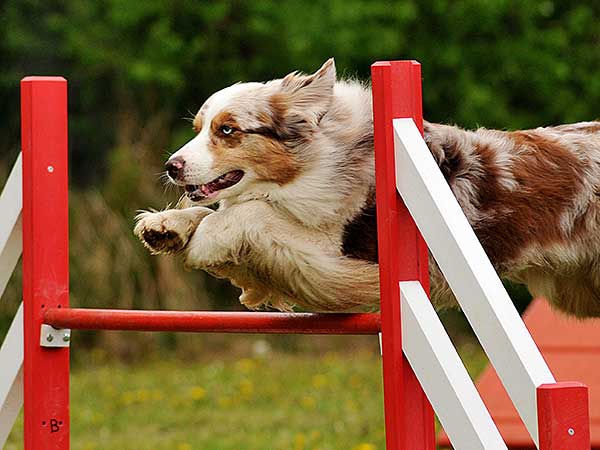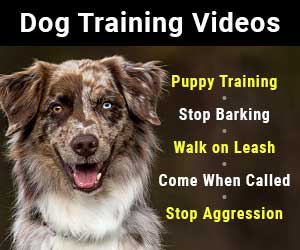
Agility Training For Dogs Is A Perfect Match For Australian Shepherds
Agility training for dogs is both a great form of exercise and a wonderful way to build communication between dog and owner. There are many benefits of engaging in this exciting sport and many ways you can go about becoming involved. If the standard walk around the block or romp in the park isn't enough for you and your dog, why not consider expanding your routine with some agility work?
If agility seems like something you may be interested in, this section of the site will give you an excellent overview of the sport. You can then purchase some beginner's guides to agility training to get you started. There is plenty of reference material out there that can teach you all about exactly what is involved in agility and how you and your dog can get involved. Once you've learned more about it, then you can begin to put what you've learned into practice.
What Is Agility Dog Training?
Agility training for dogs is essentially a sport in which your dog is required to run an obstacle course as fast as possible. It's big on dog-owner cooperation because you'll need to tell the dog exactly what to do at each obstacle, which is why is can be a great challenge for Aussies who seem to have "too much energy."
As a competitive sport, there are two main elements to a dog's score when she runs and agility course. Those are:
• time, and
• accuracy
That means it's not just a flat-out time trial. If your dog makes a mistake, either because she disobeys you or misunderstands a command, she'll be graded down. The winning dog is not necessarily the fastest or the most accurate, but the dog who can balance accuracy and speed—and Aussies excel at both.

beatrix kido / stock.adobe.com
Types of Agility Obstacles
So far you might think agility training for dogs sounds a little like a hurdle race or a steeple chase, but it's more complicated than that. There's a variety of obstacles your dog may be expected to negotiate on an agility course—they'll differ from club to club and course to course. Here are a few typical obstacles:
• A-frames
• tunnels
• see-saws
• hurdles and jumps
• weave poles (slalom)
Obviously, the first step in agility training for dogs is either buying or making your own agility set. You don't have to invest in an entire course all at once. You can start out slow with one or two individual obstacles and then go from there. This may be more convenient from not only a cost perspective but also for space, as a full course can take up a lot of room and unless you have a very large backyard, you're not likely to be able to house that much equipment at once.
Of course, there are other ways that you can get the full agility experience without buying all of your own equipment. You can purchase a simple dog agility starter kit, which contains several basic obstacles in a carrying case that allows you to transport them easily should you need to move to the park for more space. Or you can join up with friends who have a similar interest and combine equipment to create a larger course for your dogs.
Learning Agility Training For Dogs With Others
Still another option is to join an agility club. These are groups that usually have their own facilities geared toward agility training for dogs. They may have both outdoor and indoor courses, so that you and your dog can work in all kinds of weather, and can provide expert advice on proper training techniques to help you sharpen your skills. At the same time, clubs can provide a wonderful social environment for both dogs and owners.
Many people who become involved in agility training opt to move on to competitions and this entails finding a sponsoring organization such as the such as the United States Dog Agility Association, the North American Dog Agility Council or the American Kennel Club. and looking into their requirements and schedule of competitions. You may want to go and watch a competition or two before you actually begin competing so you can get a better idea of exactly what competitive agility entails.
If you do decide to move up to the competitive level, then you will also want to engage in a more advanced level of agility training for dogs. This may involve taking advanced classes and getting advice from experts so that both you and your dog can sharpen your skills and be prepared to take on even the most challenging of courses.
There is so much to be gained through agility training, whether you do it simply as a hobby or participate in competition. It's a wonderful way to create a stronger bond between you and your dog and have a lot of fun in the process. So consider trying agility work if you haven't already... you definitely won't regret it!
Have Dog Training Questions?
Check out these introductory dog training videos...
I want my dog to stop being aggressive.
I want some help training my new puppy.
I want my dog to stop barking at everything.
Get Australian Shepherd Info, Website Updates, Special Offers, and Cartoons...
FREE GIFT
You'll also receive a free copy of the ebook
My Everyday Dog Training Tools
by professional dog trainer Daniel Abdelnoor, "Doggy Dan"












 Loading Image...
Loading Image...